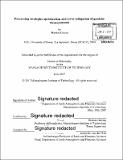| dc.contributor.advisor | Thomas Herring. | en_US |
| dc.contributor.author | Coccia, Martina | en_US |
| dc.contributor.other | Massachusetts Institute of Technology. Department of Earth, Atmospheric, and Planetary Sciences. | en_US |
| dc.date.accessioned | 2017-12-05T19:12:32Z | |
| dc.date.available | 2017-12-05T19:12:32Z | |
| dc.date.copyright | 2017 | en_US |
| dc.date.issued | 2017 | en_US |
| dc.identifier.uri | http://hdl.handle.net/1721.1/112431 | |
| dc.description | Thesis: Ph. D., Massachusetts Institute of Technology, Department of Earth, Atmospheric, and Planetary Sciences, 2017. | en_US |
| dc.description | Page 177 blank. Cataloged from PDF version of thesis. | en_US |
| dc.description | Includes bibliographical references (pages 171-176). | en_US |
| dc.description.abstract | This doctoral thesis focuses on the application of geodetic techniques and finite element modeling to studying crustal deformation and other processes. In particular, it focuses on optimizing standard processing strategies, reducing the noise in the measurements and mitigating the effects of external processes in order to extract the signal of interest. Geodetic techniques, such GPS and InSAR, are still affected by major sources of errors, such as multipath, atmospheric effects, snow, blockage of the signal by infrastructure that can make difficult the detection of geophysical signal. In this thesis, I analyze three sets of data for which I have used different approaches to estimate the displacement and to investigate the sources of deformation that contribute to the signal. The first project consists of studying the deformation caused by the seasonal cycle of injection/withdrawal of gas in a depleted gas reservoir using InSAR measurements and Finite Element modeling techniques. In this project, I present a method to reduce the atmospheric signal, using statistical techniques and filtering and to estimate the error on the measurements. I compare the estimates with Finite Element modeling of the reservoir, using an elastic rheology. The second project analyses the unrest of Katla volcano in Iceland using GPS observables. GPS stations on top of the volcano register a complex signal, caused by the concurrence of different processes, such as snow on the antenna, multipath, earthquakes, volcanic deformation and hydrological events. In this project, I explore methods to detect the effects of snow/ice on top of antennas and to separate the different sources of the signal in order to extract the volcanic deformation component. I then compare the GPS measurements with a finite element model of snow/ice load on the volcano to validate the source of the estimated deformation. The third project involves the analysis of long term deformation and determination of vibrations of the Al-Hamra tower in Kuwait, using 24-hours averaged, 6-hours averaged and 1 Hz GPS measurements. The signals of GPS stations mounted on buildings are often affected by multipath due to reflective objects on the roof and suffer from reduced accuracy due to the partial masking of the sky by infrastructures on the roof. I explore different ways to mitigate the multipath, assessing an optimal GPS processing strategy for building installation. As the resulting deformation observed by the GPS instruments is highly correlated to variations in temperature, I present a finite element model of the building, where the major source of deformation is caused by a differential heating of the external walls. I also discuss the effects of the winds on the structure of the building, analyzing the high rate GPS measurements. | en_US |
| dc.description.statementofresponsibility | by Martina Coccia. | en_US |
| dc.format.extent | 177 pages | en_US |
| dc.language.iso | eng | en_US |
| dc.publisher | Massachusetts Institute of Technology | en_US |
| dc.rights | MIT theses are protected by copyright. They may be viewed, downloaded, or printed from this source but further reproduction or distribution in any format is prohibited without written permission. | en_US |
| dc.rights.uri | http://dspace.mit.edu/handle/1721.1/7582 | en_US |
| dc.subject | Earth, Atmospheric, and Planetary Sciences. | en_US |
| dc.title | Processing strategies optimization and error mitigation of geodetic measurements | en_US |
| dc.type | Thesis | en_US |
| dc.description.degree | Ph. D. | en_US |
| dc.contributor.department | Massachusetts Institute of Technology. Department of Earth, Atmospheric, and Planetary Sciences | |
| dc.identifier.oclc | 1008776029 | en_US |
